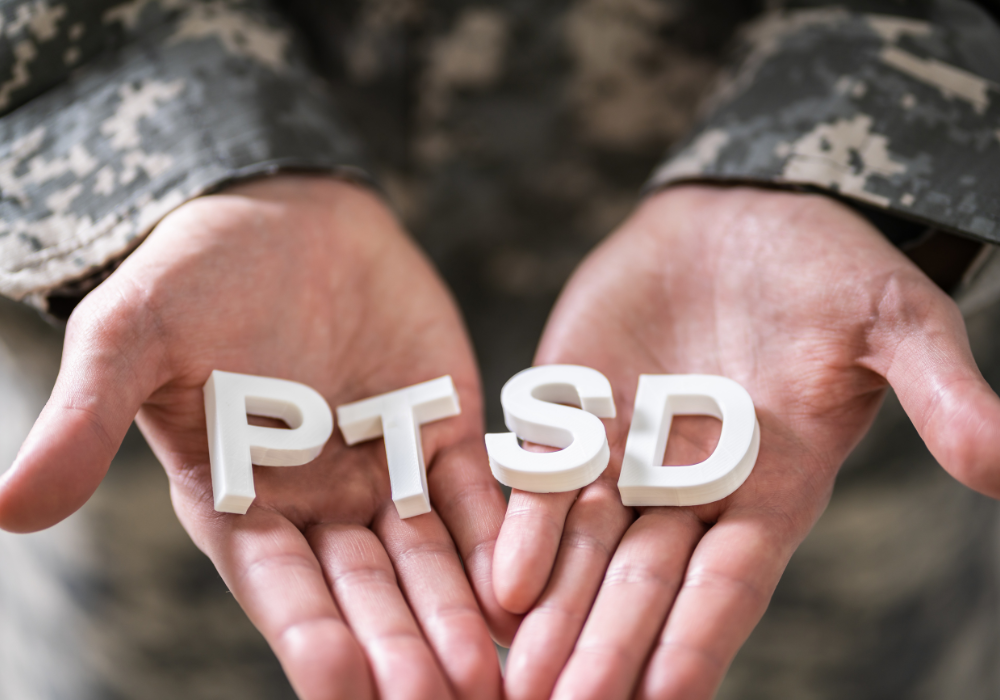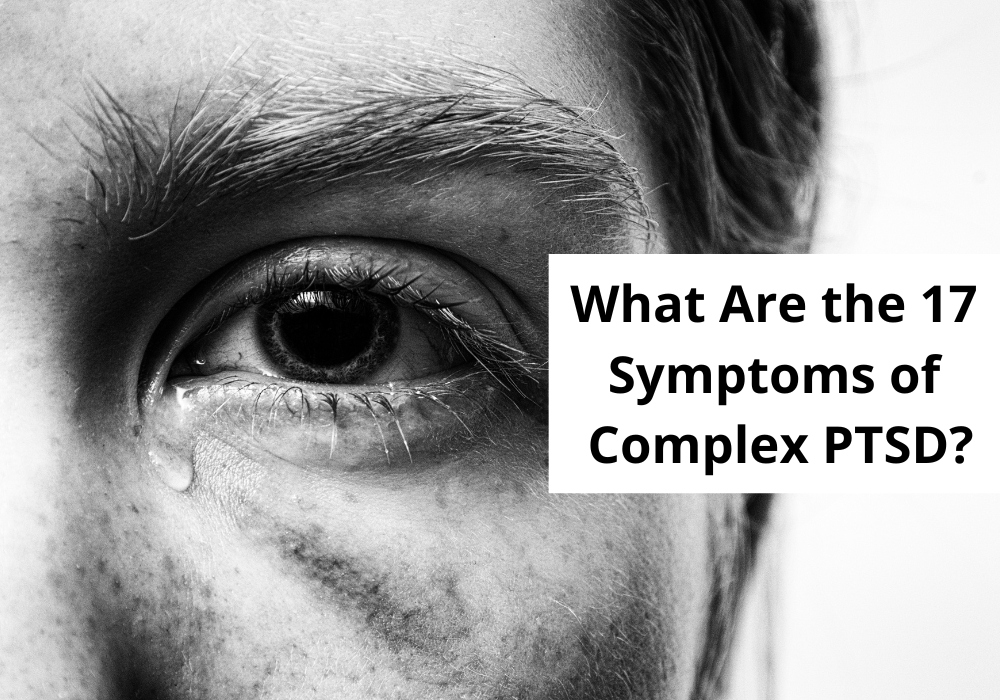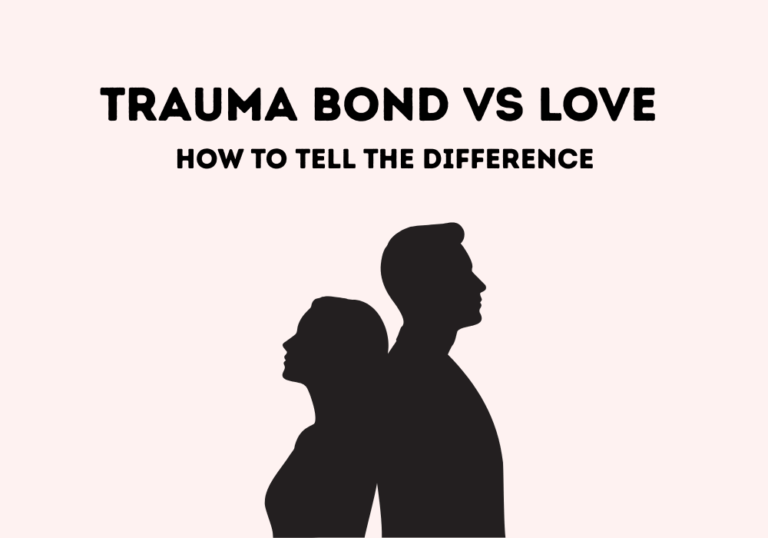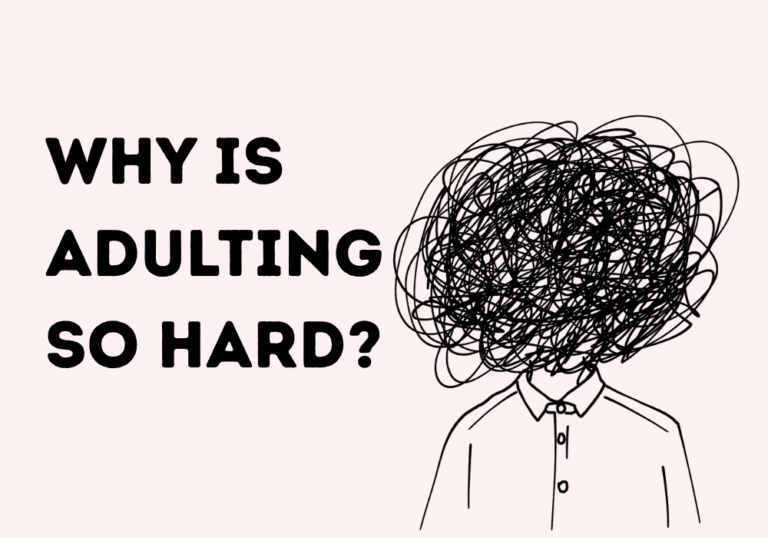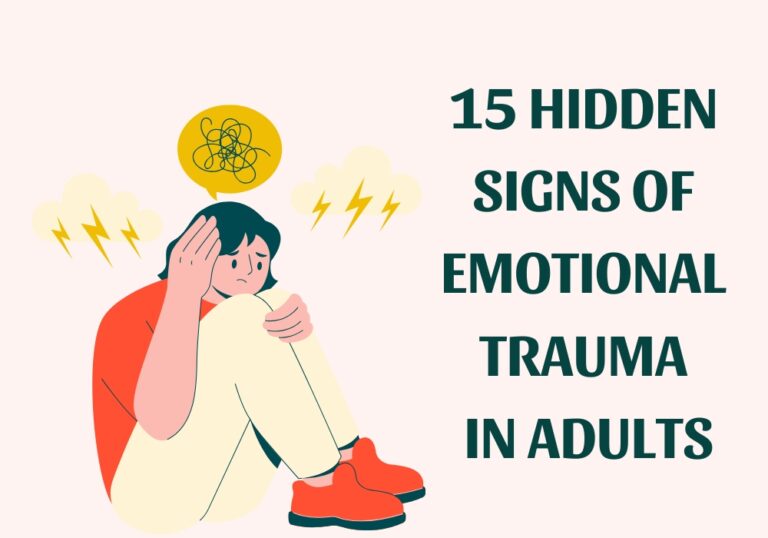Living with Complex Post-Traumatic Stress Disorder (C-PTSD) can feel like carrying an invisible weight that affects every part of your life. Unlike PTSD, which is triggered by a single traumatic event, C-PTSD develops from prolonged or repeated trauma—like emotional abuse, neglect, or domestic violence. This ongoing pain can leave you feeling powerless, disconnected, and stuck in survival mode.
But recognizing the symptoms is the first step toward healing. So, what are the 17 symptoms of complex PTSD? In this guide, we’ll break them down in a clear and relatable way, helping you understand what you’re going through and how to move forward. With the right knowledge and support, recovery isn’t just possible—it’s within reach.
C-PTSD vs. PTSD: What’s the Difference?
PTSD (Post-Traumatic Stress Disorder) and C-PTSD (Complex PTSD) are both mental health conditions caused by trauma, but they’re not the same. PTSD usually happens after a single traumatic event, like a car accident or natural disaster. It causes flashbacks, nightmares, and anxiety.
C-PTSD, on the other hand, comes from repeated trauma over a long time, like abuse or neglect. It has all the same symptoms as PTSD but also includes trouble with relationships, low self-worth, and feeling completely disconnected from the world.
Think of PTSD like a deep cut that needs stitches, while C-PTSD is more like a long-term wound that never got the chance to heal properly.
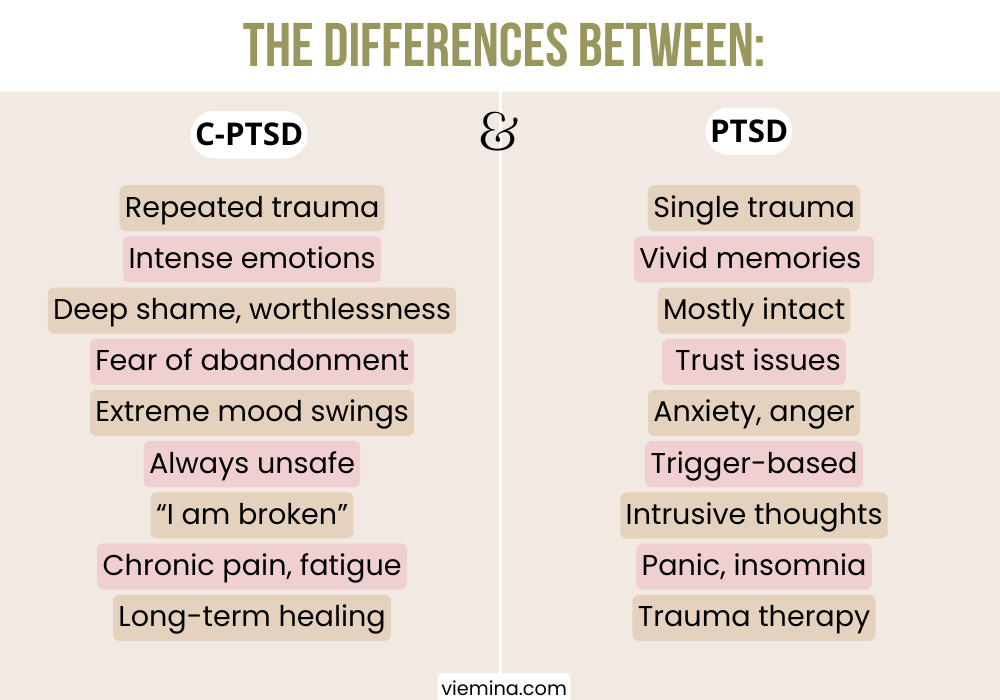
What Are the Causes of Complex Post-Traumatic Stress Disorder (C-PTSD)?
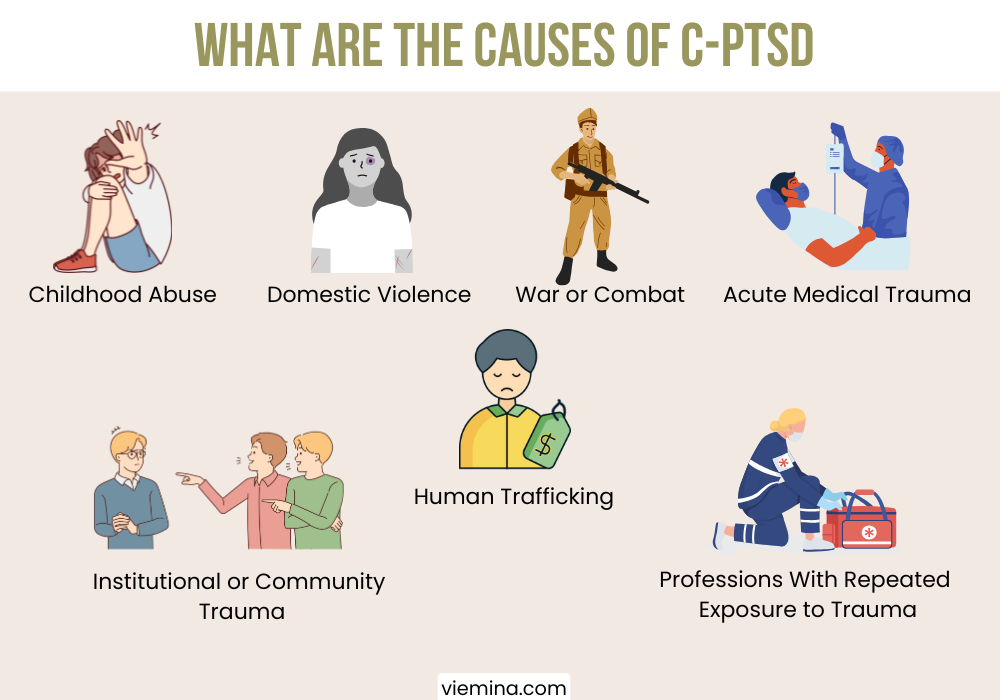
Many traumatic experiences can cause c-PTSD. These include:
1-Childhood Abuse:
Children who undergo physical, emotional, or sexual abuse are highly vulnerable. The trauma caused during their sensitive growth phase can affect them for the rest of their lives.
2-Domestic Violence:
C-PTSD can also develop in people in abusive relationships. The constant violence leads to feelings of powerlessness and dread.
3-War or Combat:
Both soldiers and civilians who experience the horrors of war often suffer from C-PTSD, as it deeply impacts their mental health.
4-Human Trafficking:
Trafficking survivors certainly undergo high levels of trauma, which include abuse, severe isolation, and manipulation, which all lead to C-PTSD.
5-Professions With Repeated Exposure to Trauma:
First responders, healthcare personnel, and military workers have to deal with death, suffering, and violence with regularity. Constant exposure to these events significantly affects one’s mental state over time.
6-Institutional or Community Trauma:
Being raised in a dysfunctional family system in a repressive, discriminatory, or socially violent society causes a persistent sense of danger and helplessness to many people.
7-Acute Medical Trauma:
Patients with prolonged hospital stays, painful medical procedures, or even medical neglect often suffer trauma that is more than just physical pain. Trauma with long-lasting psychological effects is an outcome of fear, helplessness, and isolation inflicted on these patients.
What Are the 17 Symptoms of Complex PTSD?
1-Emotional Flashbacks:
Unlike traditional PTSD, where flashbacks often come as vivid images or memories, emotional flashbacks in C-PTSD are sudden and intense waves of emotion—like fear, shame, or sadness—that make you feel like you’re reliving past trauma.
- Example: Imagine someone who was emotionally abused as a child. Years later, they receive constructive criticism at work, but instead of taking it in stride, they feel an overwhelming sense of shame and panic—just like they did in their childhood. Their brain reacts as if they are still in danger, even when they’re safe.
These flashbacks can be confusing and exhausting, often making it hard to function in daily life. But understanding them is the first step toward managing them.
2- Difficulty Regulating Emotions (Emotional Dysregulation):
People with C-PTSD often feel like their emotions are all over the place. One moment, they’re angry, the next, they’re crying, and sometimes, they just feel completely numb. It’s not that they want to react this way—it’s just how their brain has learned to cope with trauma.
- Example: Imagine getting into a small argument with a friend. Instead of just feeling annoyed, you suddenly explode with anger or break down in tears. Or maybe you don’t feel anything at all, like you’ve shut down emotionally.
These ups and downs can be exhausting, but they’re not a sign of weakness. They’re a natural response to past trauma.
3- Avoidance of Triggers:
People with C-PTSD often go out of their way to avoid anything that reminds them of their trauma. This could mean staying away from certain places, people, or situations—even if deep down, they wish they could face them.
- Example: A person who went through abuse as a child might skip family events, even if part of them wants to reconnect. Or someone who had a traumatic experience in a specific area might take a longer route just to avoid passing by it.
At first, avoidance might seem like a way to stay safe, but over time, it can make life feel smaller and more isolating.
4- Distorted Self-Perception:
C-PTSD can make a person see themselves in a harsh, negative light. They might feel broken, unworthy, or beyond repair—even when others see them differently. This deep sense of shame and self-doubt often comes from years of being mistreated or made to feel small.
- Example: Someone who was bullied growing up might believe they’re unlikable. Even when people genuinely try to befriend them, they assume it’s fake or that they don’t deserve kindness, so they pull away from social situations.
Remember: these thoughts aren’t the truth—they’re a reflection of past trauma.
5-Memory Issues (Impaired Memory):
One of the symptoms of C-PTSD is trouble with memory. Some people have gaps in their past, especially when it comes to traumatic events, while others struggle to stay focused in the present. It’s like the brain is trying to protect itself by blocking out painful memories—but in doing so, it can also make everyday recall difficult.
- Example: A person with C-PTSD might forget big parts of their childhood or completely space out during stressful conversations. They may also struggle to remember important details, even when they try to focus.
If you’re wondering, “what are the 17 symptoms of complex PTSD?”, memory issues are a big one. Trauma affects how the brain processes and stores information, making it harder to recall certain events or stay mentally present.
Related: 15 Natural Ways To Improve Your Memory Today!
6-Persistent Negative Beliefs:
People with symptoms of C-PTSD often develop deep, negative beliefs about themselves and the world. They might see themselves as unworthy, unlovable, or broken beyond repair. At the same time, they may believe the world is dangerous and that trusting others will only lead to pain. These thoughts don’t come from nowhere—they’re shaped by past trauma and repeated betrayal.
- Example: Someone who has been betrayed multiple times might assume that every new friend will eventually hurt them. Even when people show kindness, they struggle to believe it’s real and may push others away before they get too close.
Persistent negative beliefs are one of the most damaging symptoms because they shape how a person sees everything around them, often reinforcing isolation and fear.
7- Sleep Problems & Nightmares:
For many people with symptoms of C-PTSD, sleep is anything but restful. Insomnia, frequent waking, or terrifying nightmares make it hard to feel safe even when the day is over. Nighttime can bring a flood of anxiety, racing thoughts, or vivid dreams that replay traumatic experiences.
- Example: A war survivor might wake up in terror from nightmares of combat, feeling like they’re reliving the moment all over again. Others may struggle to fall asleep at all, fearing what their dreams might bring.
When asking, “what are the 17 symptoms of complex PTSD?”, disrupted sleep is a major one. Lack of rest can make everything feel harder, draining both mental and physical energy.
Related: Insomnia :Symptoms ,Causes & 10 Types
Related: Sleep Deprivation: Symptoms, Causes, & 10 Effects
8- Self-Destructive Behavior:
When someone carries deep emotional pain from past trauma, they may turn to risky behaviors as a way to cope. This can include substance abuse, reckless driving, self-harm, or other dangerous actions. At the moment, these behaviors might feel like an escape, but they often lead to more harm in the long run.
- Example: A person overwhelmed by painful memories might drink excessively to numb the pain. They may not even realize they’re putting themselves in danger—it just feels like the only way to get relief.
Self-destruction isn’t a choice people make lightly. It’s often a response to deep, unresolved trauma, making it one of the most serious and concerning effects of C-PTSD.
9-Low Self-Esteem & Lack of Purpose:
C-PTSD can make a person feel like they’re never good enough, no matter what they achieve. They may struggle with self-doubt, feel aimless, or believe they have no real purpose. Even when they have talent or potential, their trauma convinces them otherwise, holding them back from opportunities and personal growth.
- Example: A talented artist avoids pursuing a career in art because they believe they’re not good enough. Even when others praise their work, they dismiss it, feeling like a fraud.
This constant self-doubt doesn’t mean they lack ability—it’s the weight of past trauma making them question their worth.
Related: Why do I never feel passionate about anything?
Related: Low Self Esteem: 10 Effective Ways to Improve Self-Worth
10- Feeling Trapped in the Past:
For many people with C-PTSD, the past never truly feels like the past. No matter how much time has passed, the trauma still lingers, shaping their thoughts, fears, and decisions. It can feel like they’re stuck in a cycle they can’t break, as if their pain will always define them.
- Example: Someone who grew up in poverty may still feel financially insecure, even after achieving stability. No matter how much they save or how secure their job is, they live with the constant fear of losing everything.
This feeling isn’t just in their head—it’s how their brain learned to survive. But the past doesn’t have to dictate the future.
Related: 24 Powerful Techniques For Letting Go Of The Past
11- Relationship Difficulties:
For someone with C-PTSD, relationships can feel like walking a tightrope. Trusting others feels risky, and deep down, there’s often a fear of being abandoned or hurt. Some people cling too tightly, desperate for reassurance, while others keep their distance, afraid of letting anyone in. No matter how much they want love and connection, past wounds make it hard to feel truly safe with others.
- Example: A person raised by emotionally unavailable parents may struggle with romantic relationships. They might either become overly attached, fearing their partner will leave, or push them away before they get too close—just to avoid getting hurt first.
This isn’t about not wanting relationships—it’s about the fear of reliving old pain.
Related: 12 Signs Of An Unhealthy Relationship
Related: 20 Warning Signs of a Controlling Relationship
Related: 20 Warning Signs of a Controlling Relationship
12- Dissociation:
Sometimes, the mind tries to protect itself by disconnecting from reality. For people with C-PTSD, dissociation can feel like zoning out, feeling numb, or even watching themselves from the outside. It’s the brain’s way of escaping overwhelming emotions, but it can also make daily life feel distant and unreal.
- Example: Someone might suddenly feel detached during a stressful conversation, as if they’re watching themselves from the outside. Others may lose chunks of time, unable to remember what they just did or said.
Dissociation isn’t just “daydreaming”—it’s a survival response to trauma, making it one of the more unsettling effects of C-PTSD.
13- Difficulty Setting Boundaries:
For people with C-PTSD, saying “no” can feel impossible. They may struggle to set limits, overextend themselves, or let others take advantage of them—often without realizing it. On the other hand, some may build walls so high that they shut people out completely. Finding a balance between protecting themselves and allowing healthy connections can be a real challenge.
- Example: Someone who grew up in a toxic environment may have trouble standing up for themselves at work, fearing conflict or rejection. Meanwhile, another person might avoid close relationships altogether to prevent getting hurt.
Boundaries aren’t just about keeping others out—they’re about protecting one’s peace while still allowing room for connection.
Related: 7 Tips for Saying No Effectively
14-Chronic Pain & Physical Symptoms:
C-PTSD doesn’t just affect emotions—it takes a toll on the body too. Many people experience chronic pain, headaches, stomach issues, or other unexplained health problems. These physical symptoms aren’t random; they’re the body’s way of holding onto stress and trauma.
- Example: Someone with a history of emotional abuse may suffer from constant stomach aches or migraines, especially during stressful situations, even when there’s no clear medical cause.
Trauma doesn’t just live in the past—it lingers in the body, showing up in ways that can be exhausting and frustrating.
15- Emotional Numbness:
When someone has lived through prolonged trauma, their brain learns to shut down emotions as a survival mechanism. Over time, this can lead to feeling emotionally numb—disconnected from joy, sadness, or even love. Moments that should feel exciting or meaningful might instead feel distant and empty.
- Example: A person who just got engaged struggles to feel happiness, not because they don’t care, but because they’ve spent years suppressing their emotions to cope with past pain.
Emotional numbness isn’t about not wanting to feel—it’s about the mind protecting itself from being overwhelmed.
16-Depression & Crying Spells:
Depression from C-PTSD isn’t just feeling “down” now and then—it’s a heavy, constant sadness that seeps into every part of life. It affects how people think, feel, and behave. They may lose interest in things they once loved, feel guilty or worthless, and struggle with overwhelming emotions. Crying spells can happen suddenly, sometimes without a clear reason, as the body tries to process deep emotional pain.
- Example: Someone who once enjoyed painting or music may now feel numb and uninterested, spending hours in bed, unsure of how to move forward.
Depression can also cause changes in sleep, appetite, and energy levels. Some may struggle with insomnia, while others sleep excessively. At its worst, it can lead to thoughts of self-harm or suicide.
Related: Understanding The 8 Different Types of Depression
Related: How to stop Insomnia ? 10 Tips
17-Suicidal Thoughts or Behaviors:
In severe cases, the emotional pain of C-PTSD can become so overwhelming that a person may struggle with suicidal thoughts or self-harm. The weight of past trauma, combined with feelings of hopelessness, can make it hard to see a way forward. It’s not about wanting to die—it’s about wanting the pain to stop.
- Example: Someone who has battled years of abuse may feel like they’ll never escape their past, leading to thoughts of self-harm or suicide.
If you or someone you know is experiencing this, please reach out for help. Healing is possible, and no one has to go through it alone.
Understanding what are the 17 symptoms of complex PTSD is the first step toward healing. With the right support, recovery is possible.
Related: Why do I never feel passionate about anything?
Conclusion:
Complex PTSD is real, and its impact runs deep. Many people struggle with its symptoms without even realizing what they’re going through. But understanding the 17 symptoms of complex PTSD and recognizing these struggles is the first step toward healing. It also helps shed light on the effects of prolonged trauma and the importance of seeking support.
Recovery is possible through therapy, self-awareness, and a strong support system. If you or someone you know is experiencing these symptoms, don’t hesitate to reach out for help.
Healing takes time, but no one has to go through it alone.
Related: What Are The 5 Stages Of PTSD: All What You Need to Know
